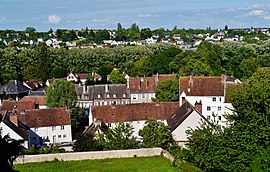
Back ሻርትረ Amharic Chartres AN شارتر Arabic شارتر ARZ Chartres AST Şartr Azerbaijani شارتر AZB Шартр Byelorussian Шартр BE-X-OLD Шартър Bulgarian
Chartres | |
|---|---|
Prefecture and commune | |
 Cityscape from Chartres Cathedral | |
| Coordinates: 48°27′22″N 1°29′02″E / 48.456°N 1.484°E | |
| Country | France |
| Region | Centre-Val de Loire |
| Department | Eure-et-Loir |
| Arrondissement | Chartres |
| Canton | Chartres-1, 2 and 3 |
| Intercommunality | CA Chartres Métropole |
| Government | |
| • Mayor (2020–2026) | Jean-Pierre Gorges[1] |
Area 1 | 16.85 km2 (6.51 sq mi) |
| • Metro (2020) | 1,923.2 km2 (742.6 sq mi) |
| Population (2022)[2] | 37,990 |
| • Density | 2,300/km2 (5,800/sq mi) |
| • Metro (Jan. 2019[3]) | 170,763 |
| • Metro density | 89/km2 (230/sq mi) |
| Time zone | UTC+01:00 (CET) |
| • Summer (DST) | UTC+02:00 (CEST) |
| INSEE/Postal code | 28085 /28000 |
| Elevation | 121–161 m (397–528 ft) (avg. 142 m or 466 ft) |
| 1 French Land Register data, which excludes lakes, ponds, glaciers > 1 km2 (0.386 sq mi or 247 acres) and river estuaries. | |
Chartres (French pronunciation: [ʃaʁtʁ] ⓘ) is the prefecture of the Eure-et-Loir department in the Centre-Val de Loire region in France. It is located about 90 km (56 mi)[4] southwest of Paris. At the 2019 census, there were 170,763 inhabitants in the metropolitan area of Chartres (as defined by the INSEE),[3] 38,534 of whom lived in the city (commune) of Chartres proper.[5]
Chartres is famous worldwide for its cathedral. Mostly constructed between 1193 and 1250, this Gothic cathedral is in an exceptional state of preservation. The majority of the original stained glass windows survive intact, while the architecture has seen only minor changes since the early 13th century.[6] Part of the old town, including most of the library associated with the School of Chartres, was destroyed by Allied bombs in 1944.
- ^ "Répertoire national des élus: les maires" (in French). data.gouv.fr, Plateforme ouverte des données publiques françaises. 13 September 2022.
- ^ "Populations de référence 2022" (in French). The National Institute of Statistics and Economic Studies. 19 December 2024.
- ^ a b INSEE. "Statistiques locales - France par aire d'attraction des villes - Population municipale 2019". Retrieved 5 June 2022.
- ^ Google maps gives 91 km town hall to town hall; it is less city limit to city limit and less far again as the crow flies.
- ^ INSEE. "Historique des populations communales - Recensements de la population 1876-2019" (in French). Retrieved 5 June 2022.
- ^ "Chartres, the Gothic Cathedral near Paris". Paris Digest. 2018. Retrieved 10 September 2018.



